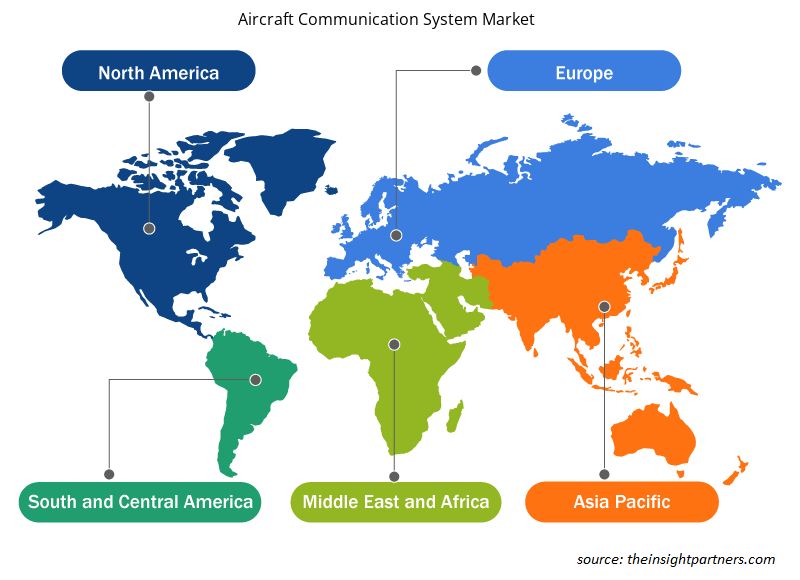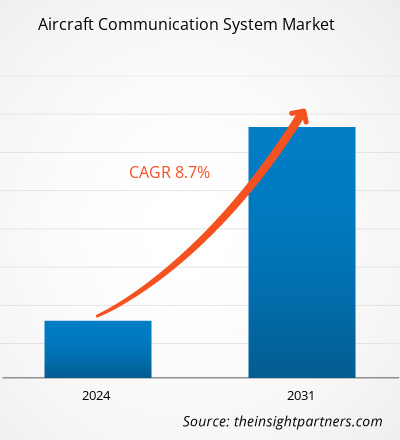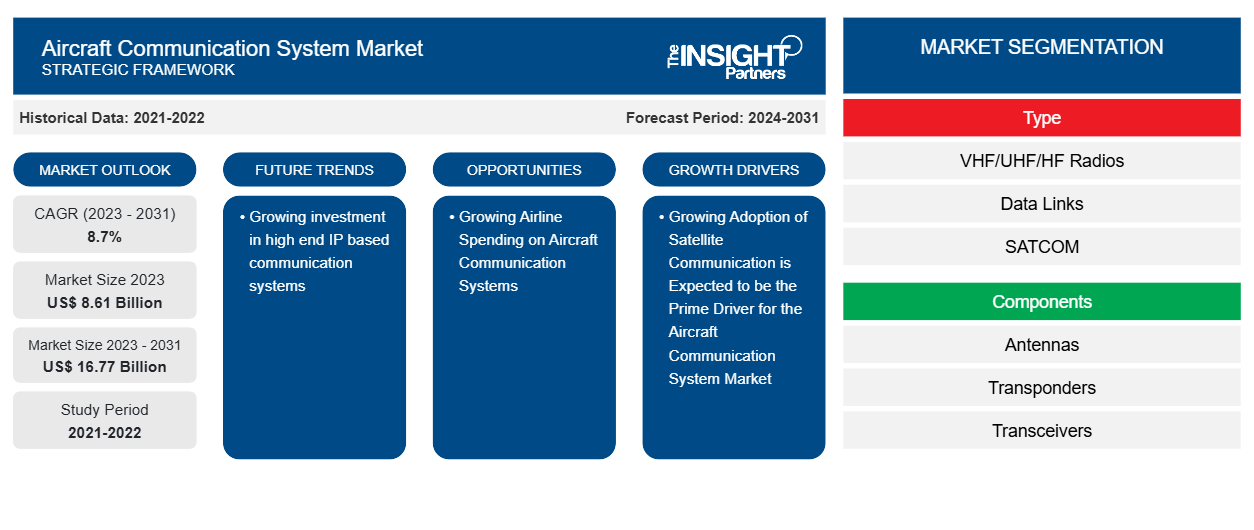Der Markt für Flugzeugkommunikationssysteme soll von 8,61 Milliarden US-Dollar im Jahr 2023 auf 16,77 Milliarden US-Dollar im Jahr 2031 anwachsen. Der Markt soll in den Jahren 2023–2031 eine durchschnittliche jährliche Wachstumsrate von 8,7 % verzeichnen. Die wachsende Nachfrage nach Echtzeitinformationen, Datenaustausch und Konnektivität ist ein wichtiger Antriebsfaktor für den weltweiten Markt für Flugzeugkommunikationssysteme. Die zunehmende Einführung von High-End-Kommunikationssystemen wie SATCOM verbessert das Passagiererlebnis und das Flugverkehrsmanagement, was ebenfalls ein wichtiger Antriebsfaktor für den weltweiten Markt für Flugzeugkommunikationssysteme ist.
Marktanalyse für Flugzeugkommunikationssysteme
Flugzeugkommunikationssysteme werden hauptsächlich für den Datenaustausch, die Sprachübertragung, den Echtzeit-Informationsaustausch und den Empfang zwischen Flugzeugen oder Bodenstationen genutzt. Die Flugzeugkommunikationssysteme verbessern die Erfahrung der satellitengestützten Navigationsüberwachung, was sich positiv auf das Wachstum des Flugzeugkommunikationsmarktes auswirkt. Meistens implementieren Anbieter auf dem Flugzeugkommunikationsmarkt fortschrittliche Technologien wie Flugverkehrsmanagement durch drahtlose Kommunikationstechnologien und Hochgeschwindigkeitsverbindungsbahnen. Diese großen Anbieter von Flugzeugkommunikationssystemen investieren erheblich in ihre Forschungs- und Entwicklungsaktivitäten, um technologisch verbesserte Kommunikationssysteme für militärische und kommerzielle Flotten herzustellen, was die Entwicklung des Flugzeugkommunikationssystemmarktes im Prognosezeitraum voraussichtlich vorantreiben wird.
Marktübersicht für Flugzeugkommunikationssysteme
Der technologische Fortschritt in der Luftfahrtelektronik, der Kommunikationsinfrastruktur und der Managementkontrollsysteme hat große Auswirkungen auf die Entwicklung des Marktes für Flugzeugkommunikation. Die Flugzeugkommunikation hat die Zahl der Flugunfälle erheblich verringert und das Kommunikationsnetz in Notfällen verbessert. Darüber hinaus wird erwartet, dass der Aufwärtstrend bei satellitengestützten Navigationssystemen zur Verkürzung der Flugzeit und zur Verkürzung der Komplexität des Flugverkehrsmanagements das Wachstum des Marktes für Flugzeugkommunikationssysteme ankurbeln wird.
Passen Sie diesen Bericht Ihren Anforderungen an
Sie erhalten kostenlos individuelle Anpassungen an jedem Bericht, einschließlich Teilen dieses Berichts oder einer Analyse auf Länderebene, eines Excel-Datenpakets sowie tolle Angebote und Rabatte für Start-ups und Universitäten.
-
Holen Sie sich die wichtigsten Markttrends aus diesem Bericht.Dieses KOSTENLOSE Beispiel umfasst eine Datenanalyse von Markttrends bis hin zu Schätzungen und Prognosen.
Markttreiber und Chancen für Flugzeugkommunikationssysteme
Die zunehmende Nutzung der Satellitenkommunikation dürfte der Haupttreiber für den Markt für Flugzeugkommunikationssysteme sein
Der wachsende technologische Fortschritt in der Luftfahrtindustrie fördert die Anwendung satellitengestützter Kommunikationsinfrastruktur. Die Verbreitung von Software Defined Radio zum Aufbau von Satellitenkommunikationsnetzen ist ein wichtiger Treiber für den Markt für Flugzeugkommunikationssysteme. Die Satellitenkommunikationsinfrastruktur umfasst eine breite Palette von Netzwerktechnologien für bequeme und reibungslose Konnektivitätsdienste zwischen Flotte und Bodenpersonal. Die Flexibilität und die Hochgeschwindigkeitsverbindung treiben die Nachfrage nach Satellitenkommunikationssystemen an, die wiederum ein wichtiger Antriebsfaktor für den Markt für Flugzeugkommunikationssysteme weltweit sind.
Steigende Ausgaben der Fluggesellschaften für Bordkommunikationssysteme
Die Flugzeughersteller konzentrieren sich auf die Integration hochentwickelter Kommunikationssysteme für ein besseres Betriebsmanagement. Die hochentwickelten Flugzeugkommunikationssysteme helfen dabei, in Notfällen bequem eine ordnungsgemäße Verbindung zwischen Flugzeug und Bodenbasis herzustellen. Darüber hinaus verringern sie auch das Risiko von Flugzeugunfällen. Der Austausch von Echtzeitdaten zu Flugzeiten, Position, Zustand und Steuerung ist ein wichtiges Merkmal von Flugzeugkommunikationssystemen. Bei Verkehrsflugzeugen ist die Kommunikation zwischen Pilot und Bodenpersonal zum Zeitpunkt des Starts und der Landung von entscheidender Bedeutung. Darüber hinaus tauschen Militär- oder Verteidigungsflugzeuge auch wichtige Informationen zu Missionen aus, wie z. B. Zielposition, Treibstoffstatus, Flottenstandort und kritische missionsbezogene Informationen. Die wachsende Bedeutung von Kommunikationsnetzwerken im Luftfahrtsektor wird voraussichtlich das Wachstum des Marktes für Flugzeugkommunikationssysteme im Prognosezeitraum vorantreiben.
Segmentierungsanalyse des Marktberichts für Flugzeugkommunikationssysteme
Wichtige Segmente, die zur Ableitung der Marktanalyse für Flugzeugkommunikationssysteme beigetragen haben, sind Typ, Komponenten und Flugzeugtyp.
- Basierend auf dem Typ wurde der Markt für Flugzeugkommunikationssysteme in VHF/UHF/HF-Funkgeräte, Datenverbindungen und SATCOM unterteilt. Das Segment VHF/UHF/HF-Funkgeräte hatte im Jahr 2023 einen größeren Marktanteil.SATCOM. The VHF/UHF/HF Radios segment held a larger market share in 2023.
- In Bezug auf die Komponenten wurde der Markt in Antennen, Transponder, Transceiver sowie Displays und Prozessoren segmentiert. Das Transpondersegment dominierte den Markt im Jahr 2023.
- In Bezug auf den Flugzeugtyp wurde der Markt in Verkehrsflugzeuge und Militärflugzeuge segmentiert. Die kommerziellen Segmente dominierten den Markt im Jahr 2023.
Marktanteilsanalyse für Flugzeugkommunikationssysteme nach Geografie
Der geografische Umfang des Marktberichts über Flugzeugkommunikationssysteme ist hauptsächlich in fünf Regionen unterteilt: Nordamerika, Europa, Asien-Pazifik, Naher Osten und Afrika sowie Südamerika.
Nordamerika war im Jahr 2023 Marktführer auf dem Markt für Flugzeugkommunikationssysteme. Die Region Nordamerika umfasst die USA, Kanada und Mexiko. Hohe Investitionen in fortschrittliche Technologien und drahtlose Konnektivität für den Flugsektor wirken als Haupttreiber für den Markt. Die hohe Präsenz von Fluggesellschaften und großen Herstellern von Flugzeugkommunikationssystemen treibt auch das Wachstum des Marktes für Flugzeugkommunikationssysteme in Nordamerika voran. Zunehmende Forschungs- und Entwicklungsaktivitäten im Luftfahrtsektor zur Verbesserung der Funktionen von Verkehrs- und Verteidigungsflugzeugen für eine verbesserte Kommunikationsinfrastruktur treiben das Wachstum des Marktes für kommerzielle Flugzeugsysteme in Nordamerika voran.
Regionale Einblicke in den Markt für Flugzeugkommunikationssysteme
Die regionalen Trends und Faktoren, die den Markt für Flugzeugkommunikationssysteme im Prognosezeitraum beeinflussen, wurden von den Analysten von Insight Partners ausführlich erläutert. In diesem Abschnitt werden auch die Marktsegmente und die Geografie von Flugzeugkommunikationssystemen in Nordamerika, Europa, im asiatisch-pazifischen Raum, im Nahen Osten und Afrika sowie in Süd- und Mittelamerika erörtert.

- Erhalten Sie regionale Daten zum Markt für Flugzeugkommunikationssysteme
Umfang des Marktberichts für Flugzeugkommunikationssysteme
| Berichtsattribut | Details |
|---|---|
| Marktgröße im Jahr 2023 | 8,61 Milliarden US-Dollar |
| Marktgröße bis 2031 | 16,77 Milliarden US-Dollar |
| Globale CAGR (2023 - 2031) | 8,7 % |
| Historische Daten | 2021-2022 |
| Prognosezeitraum | 2024–2031 |
| Abgedeckte Segmente |
Nach Typ
|
| Abgedeckte Regionen und Länder |
Nordamerika
|
| Marktführer und wichtige Unternehmensprofile |
|
Dichte der Marktteilnehmer für Flugzeugkommunikationssysteme: Auswirkungen auf die Geschäftsdynamik verstehen
Der Markt für Flugzeugkommunikationssysteme wächst rasant, angetrieben durch die steigende Nachfrage der Endnutzer aufgrund von Faktoren wie sich entwickelnden Verbraucherpräferenzen, technologischen Fortschritten und einem größeren Bewusstsein für die Vorteile des Produkts. Mit steigender Nachfrage erweitern Unternehmen ihr Angebot, entwickeln Innovationen, um die Bedürfnisse der Verbraucher zu erfüllen, und nutzen neue Trends, was das Marktwachstum weiter ankurbelt.
Die Marktteilnehmerdichte bezieht sich auf die Verteilung von Firmen oder Unternehmen, die in einem bestimmten Markt oder einer bestimmten Branche tätig sind. Sie gibt an, wie viele Wettbewerber (Marktteilnehmer) in einem bestimmten Marktraum im Verhältnis zu seiner Größe oder seinem gesamten Marktwert präsent sind.
Die wichtigsten auf dem Markt für Flugzeugkommunikationssysteme tätigen Unternehmen sind:
- Honeywell International Inc
- Northrop Grumman Corporation
- General Dynamics Corporation
- L3Harris Technologies Inc
- Cobham Plc
- Thales-Gruppe
Haftungsausschluss : Die oben aufgeführten Unternehmen sind nicht in einer bestimmten Reihenfolge aufgeführt.

- Überblick über die wichtigsten Akteure auf dem Markt für Flugzeugkommunikationssysteme
Nachrichten und aktuelle Entwicklungen zum Markt für Flugzeugkommunikationssysteme
Der Markt für Flugzeugkommunikationssysteme wird durch die Erfassung qualitativer und quantitativer Daten nach Primär- und Sekundärforschung bewertet, die wichtige Unternehmensveröffentlichungen, Verbandsdaten und Datenbanken umfasst. Im Folgenden finden Sie eine Liste der Entwicklungen auf dem Markt für Flugzeugkommunikationssysteme und Strategien:
- Im August 2023 schloss die Northrop Grumman Corporation in Zusammenarbeit mit der US Air Force eine Demonstration des integrierten luftgestützten Missionstransfers (IAMT) mit der B-2 Spirit auf der Whiteman Air Force Base ab. (Quelle: Northrop Grumman Corporation, Pressemitteilung/Unternehmenswebsite/Newsletter)
- Im April 2024 übernahm die Thales Group Cobham Aerospace Communications, um ihre Position im Bereich der Cockpit-Sicherheitskommunikation zu stärken. (Quelle: Thales Group, Pressemitteilung/Unternehmenswebsite/Newsletter)
Marktbericht zu Flugzeugkommunikationssystemen – Umfang und Ergebnisse
Der Bericht „Marktgröße und Prognose für Flugzeugkommunikationssysteme (2021–2031)“ bietet eine detaillierte Analyse des Marktes, die die folgenden Bereiche abdeckt:
- Marktgröße und Prognose auf globaler, regionaler und Länderebene für alle wichtigen Marktsegmente, die im Rahmen des Projekts abgedeckt sind
- Marktdynamik wie Treiber, Beschränkungen und wichtige Chancen
- Wichtige Zukunftstrends
- Detaillierte PEST-Analyse
- Globale und regionale Marktanalyse mit wichtigen Markttrends, wichtigen Akteuren, Vorschriften und aktuellen Marktentwicklungen
- Branchenlandschaft und Wettbewerbsanalyse, einschließlich Marktkonzentration, Heatmap-Analyse, prominenten Akteuren und aktuellen Entwicklungen
- Detaillierte Firmenprofile mit SWOT-Analyse
- Historische Analyse (2 Jahre), Basisjahr, Prognose (7 Jahre) mit CAGR
- PEST- und SWOT-Analyse
- Marktgröße Wert/Volumen – Global, Regional, Land
- Branchen- und Wettbewerbslandschaft
- Excel-Datensatz
Aktuelle Berichte
Erfahrungsberichte
Grund zum Kauf
- Fundierte Entscheidungsfindung
- Marktdynamik verstehen
- Wettbewerbsanalyse
- Kundeneinblicke
- Marktprognosen
- Risikominimierung
- Strategische Planung
- Investitionsbegründung
- Identifizierung neuer Märkte
- Verbesserung von Marketingstrategien
- Steigerung der Betriebseffizienz
- Anpassung an regulatorische Trends























 Kostenlose Probe anfordern für - Markt für Flugzeugkommunikationssysteme
Kostenlose Probe anfordern für - Markt für Flugzeugkommunikationssysteme